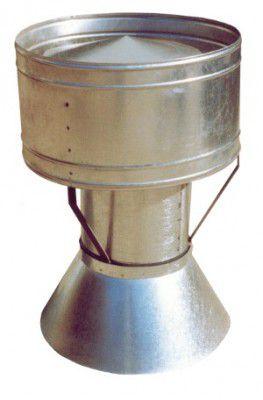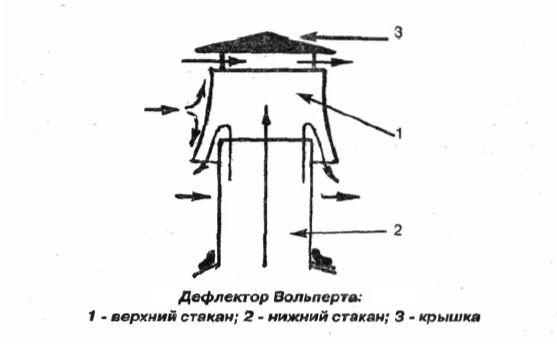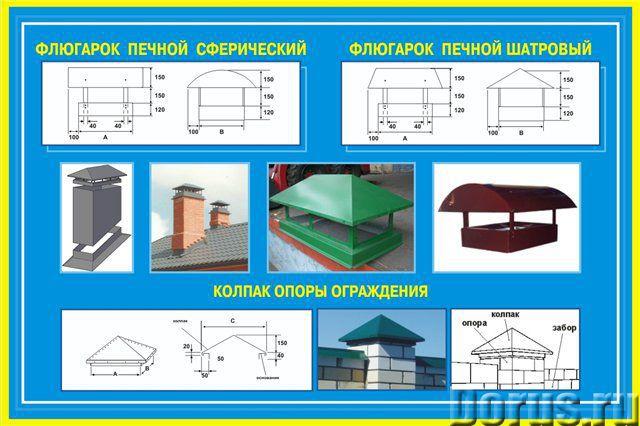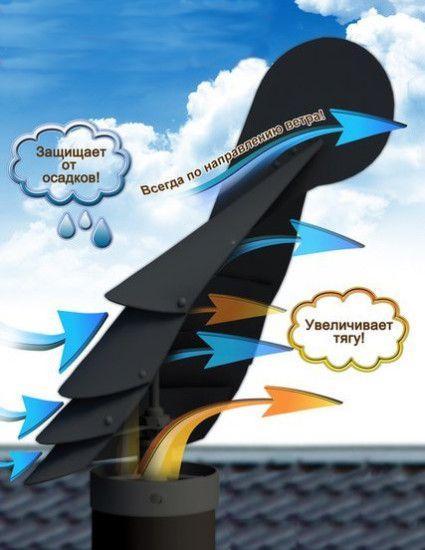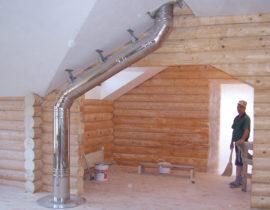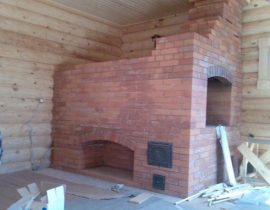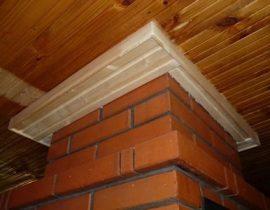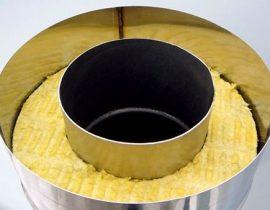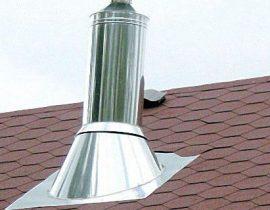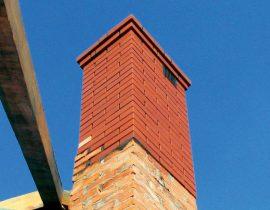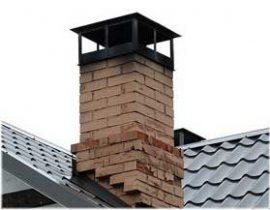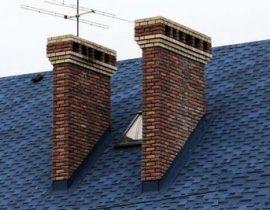For thermal installations that operate on various types of fossil fuels, an indispensable condition for uninterrupted and efficient operation is the installation of high-quality smoke exhaust systems. In order for the fuel in your stove or boiler to burn with full heat transfer, it is necessary to organize an air flow to the furnace space, and combustion products and smoke must be removed not only from the furnace, but also outside the building. In the event that the heating device does not provide for the installation of an air pressurization system, then the draft in the furnace is created exclusively by the chimney system. The flue vane on the chimney pipe is the completion of the flue system and contributes to ensuring the smooth and efficient operation of the furnace.
weather vane on the chimney pipe - photo
Wind vanes and deflectors are installed on the heads of pipes and are designed to deflect the smoke flow in accordance with the direction of the prevailing wind. Actually, the name “deflector” itself is a tracing paper from the Latin concept of “reject”.
Deflectors and weather vanes are designed to ensure complete removal of gases from the chimney system. Stagnation and incomplete removal of combustion products occur in chimneys for the following reasons:
- Strong gusty winds can interfere with the normal exit of combustion products from the chimney. Wind blowing into an unprotected chimney head can disrupt the draft of the chimney.
- Also, the incorrect location of the chimney on the roof may interfere with the incomplete removal of combustion products.
- Combustion products can stagnate in the pipe due to its incorrect design: insufficient section and an excessive number of elbows with bends.
Content
- The fundamental difference between a weather vane and a chimney deflector
- The design of deflectors and wind vanes on chimneys
- How to make a do-it-yourself chimney deflector
- Purpose and arrangement of the chimney flue vane
- Everything you need to know about the operation of the wind vane is shown in this video
The fundamental difference between a weather vane and a chimney deflector
Vanes and deflectors on chimney heads act on aerodynamic principles, forming a stable draft in the chimney, regardless of the current direction of the wind flow. These devices change the vector of movement of the air mass, directing it to the side that provides the most efficient removal of combustion products.
When using wind vanes and deflectors, the wind does not interrupt the flow of outflowing combustion products, but enhances it. These devices also compensate for the reduction in draft caused by the turns in the chimney system.
A properly selected deflector or wind vane provides an increase in the efficiency of the chimney up to 20 percent. Also, this equipment protects the smoke duct from atmospheric precipitation.
Deflectors and weather vanes can be installed both on individual and collective chimney systems. These devices can also be placed on ventilation pipes, including garbage chute ventilation systems.
The design of deflectors and wind vanes on chimneys
The main parts of deflectors and wind vanes installed on chimneys are the following parts:
- At the bottom is a cylinder, which can be made of metal, ceramic or asbestos.
- Next, the top glass is attached to the cylinder. It is fixed on several racks and has the shape of a truncated cone, expanding downwards.
- To protect against atmospheric precipitation, an umbrella-cap having a cone-shaped shape is mounted on the upper glass-diffuser.
The upper and lower parts of the diffuser can be equipped with annular baffles. They deflect the wind flow from the vertical direction. The design of deflectors and weather vanes is calculated in such a way that the wind flow from any direction does not interfere with the effective outflow of combustion products from the chimney, but forms a stable draft in the pipe.
The material for the manufacture of deflectors and weathervanes is usually galvanized steel. Such a material is almost ideal for working in aggressive environmental conditions: after all, these devices are affected not only by ordinary precipitation, but also by hot combustion products. This combination can cause accelerated corrosion of any unprotected metal.
The principle of operation of the chimney pipe deflector
The principle of operation of the deflector is based on the following aerodynamic principles:
Under the influence of the wind flow from top to bottom, the suction of the outflowing combustion products through the lower annular hole begins.
If the wind begins to blow from the bottom up, then the gases begin to flow out already through the upper annular channel.
If the wind flow is directed parallel to the horizon, then the combustion products are removed through both holes.
The deflector of this design shows the smallest level of thrust if the wind flow is directed from bottom to top. In this case, the upper umbrella prevents the outflow of gases.In order to prevent interruptions in work, the umbrella can be made in the form of two cone-shaped structures connected by wide parts. In this case, the negative aspects of the deflector are compensated.
How to make a do-it-yourself chimney deflector
Having understood for yourself the principle of operation of the deflector on the chimney, you can start making it yourself. The installation process of the deflector is as follows:
After the formation of the lower glass, three or four racks are fixed on it.
The upper cylinder is attached to the lower part of the deflector. This can be done with clamps.
By means of brackets, a cap is fixed to the upper part of the deflector.
When installing a deflector with a round section on a square chimney, adapter pipes are used.
If the chimney has a too large section (for example, a chimney), then a set of supports made of steel is used to connect it to the deflector.
Purpose and arrangement of the chimney flue vane
Oddly enough, but a weather vane, or rather a weather vane, is not only a home decoration, but also a device that provides an increase in draft in the chimneys of heating systems without using additional power sources, such as electricity.
This device protects the head of the chimney from the wind.
The wind vane consists of a cone-shaped cover, a half-cylinder-shaped screen and, in fact, a weather vane. The whole device is mounted on a bearing or on a freely rotating axle.
The wind vane is a movable device that changes its position depending on the direction of the wind flow and thereby protects the pipe head from the effects of wind.
In the wind - the wind vane turns to its stream with a convex semi-cylindrical part. The wind bends around the head of the pipe and increases the draft in the chimney system, producing a kind of "suction" of combustion products.
The wind vane can be used in a variety of systems. A significant disadvantage of such devices is the rapid wear of moving elements that provide free rotation. In addition, in winter, moisture can accumulate and freeze in the moving parts of the wind vane, which significantly reduces its efficiency. During periods of severe frost, moisture can freeze, the weather vane will stop rotating, which will lead to the opposite effect: the wind will start to pump air and blow it into the chimney and boiler! As a result, such devices are not recommended for use in areas with harsh climatic conditions. In this case, it is better to use classic deflectors on the chimney pipes.
The use of deflectors and wind vanes will ensure the efficient operation of the thermal systems of your facility.
Everything you need to know about the operation of the wind vane is shown in this video


